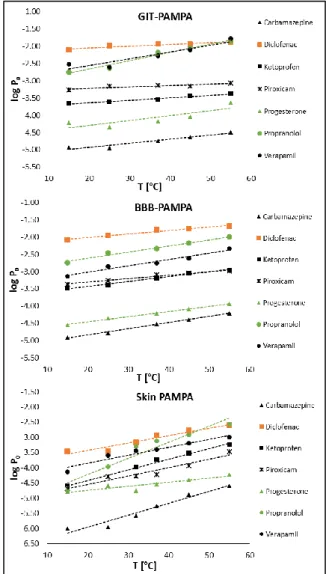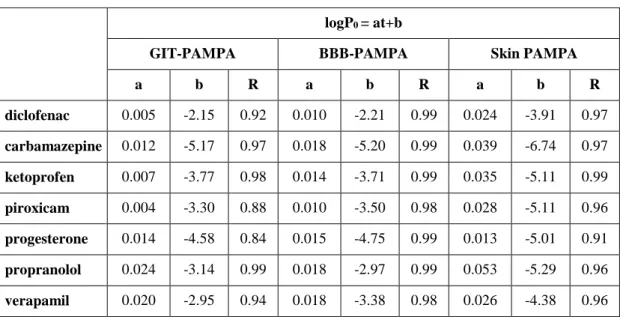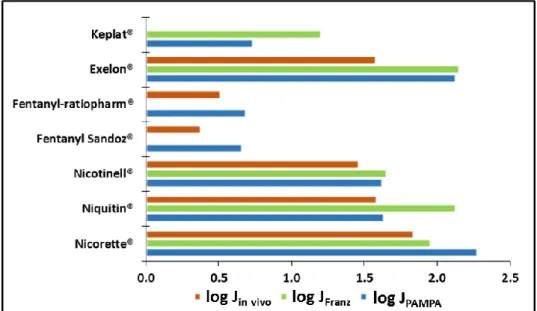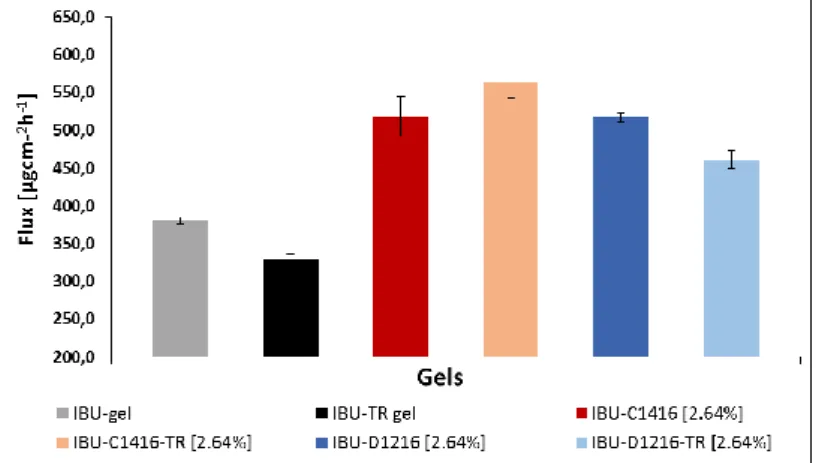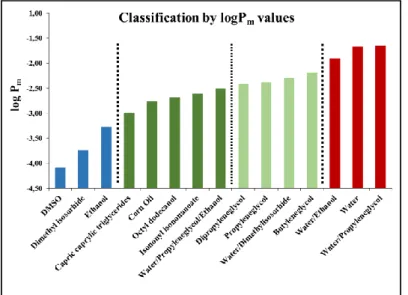Examination of permeability of drugs by PAMPA method in theoretical and practical aspects
Ph.D. thesis
Gábor Vizserálek
Semmelweis University
Doctoral School of Pharmaceutical Sciences
Supervisor: Krisztina Dr. Takács-Novák, D.Sc.
Opponents: György Dr. Keserű, D.Sc.
Marianna Dr. Budai, Ph.D.
Final Exam Committee
Chairman: Zoltán Dr. Vincze, C.Sc.
Members: Pál Dr. Perjési, C.Sc.
Szabolcs Dr. Osváth, Ph.D.
Budapest
2016
1
Introduction
From the 1990s parallel to the appearance of high-throughput screening methods and combinatorial chemistry, the possibility of developing a molecule into a pharmaceutical product also came into focus. Detailed physico-chemical profiling of molecules can help the prediction of inconvenient pharmacokinetic properties. In the past, determination of ionization and lipophilicity of molecules meant the whole physico-chemical profiling, however later it became obvious that solubility and permeability of the molecules also gives essential information on their behaviour in the human body.
Permeability – in contrast to the thermodinamic physico-chemical constants describing equitation processes (protonation constants, lipophilicity, solubility – is a kinetic parameter which states the rate of diffusion through the membrane. Thus permeability is the feature of how well the molecules can go through biological membranes. Hence, investigation of this parameter in the early stages of development is inevitable, and for this the PAMPA (parallel artificial membrane permeability assay) method can be a good alternative.
PAMPA method is a high-throughput method for the measurement of passive, transcellular permeability of molecules. Advantages compared to the experiments executed on Caco-2 cell-lines is the faster, easier and cheaper execution. Basis of the procedure is a sandwich of two, 96-well microtiter plates fitting into each other from which the upper one contains a ~ 45 µm pore-size PVDF filter at its bottom part. Artificial membrane is formed on thif filter (Fig. 1.). After the appropriate time of incubation, plates of the PAMPA sandwich is taken apart and concentration of the compound in the acceptor and donor phase is determined with a suitable analytical method. Permeability of compounds can be calculated from these concentration values. Results of permeability measurements are effected by multiple experimental parameters as the composition of the lipid membrane, the presence of the unstirred water layer (UWL), pH differences between the donor and acceptor phases, also the composition of the solution on both sides of the membrane, furthermore the inevitable effect of the incubation temperature.
Fig. 1. Structure of the PAMPA sandwich (a), the schematic view of the PAMPA plates (b). Source of Fig. 1/a:
Millipore
2
While forming the PAMPA membrane we have the opportunity to optimize the quantity and quality of the phospholipids composing the artificial membrane to achieve a membrane- composition similar to the desired human tissue and hence mimicing it the most (biomimetic).
As such, gastrointestinal (GIT-PAMPA), blood brain barrier (BBB-PAMPA) and in 2012 also a method describing the absorption through skin (Skin PAMPA) have been developed.
Pharmaceutical and cosmetic industry shows high interest in the Skin PAMPA.
In the course of developing transdermal therapeutic systems their advantages soon and clearly became obvious (long drug administration, controlled drug release, avoiding the first- pass metabolism, increasing compliance). Besides the potential advantages, the difficoulties originating from the primary (protective) function of the skin were also known. Development of a transdermal therapeutic system needs a long time and highly notable amount of financial support. The effectiveness of research strongly depends on those methods modelling the absorption of molecules through skin the best at the earliest possible stage of development.
Thereby excluding the technological arrangements and molecules with unfavourable features from further studies at an early stage. Development of Skin PAMPA meant a huge step on this field as it gave the opportunity to quickly, effectively and cost-efficiently investigate different forms of dermal and transdermal products.
3
Aims
Taking into consideration that systematic study on the effect of temperature on the PAMPA method has not been examined so far, one of the aims of our project (A) was the investigation of it. Permeability of seven molecules with distinct structural and quality behaviour, between 15 and 55 °C incubation temperatures, on three different PAMPA methods were aimed to be investigated. Further aim was to investigate that which incubation temperature used on the PAMPA method correlates best with other in vitro methods. For this purpose, we have widened the group of the test molecules and compared the data measured on the blood- brain barrier PAMPA with data of blood-brain concentration ratios (logBB) from literature. We also aimed to correlate the permeability data measures on the Skin PAMPA with the data measured on Franz diffusion cell method at the authentic, 32 °C temperature of the skin.
After the introduction of Skin PAMPA in 2012, a really strong demand was raised to further develop this method to be suitable for the testing of different dermal and transdermal products. This part of my PhD thesis can be divided into three sub-parts (B-D).
B) Improvement of Skin PAMPA method for the investigation of pharmaceutical patches. For this purpose seven different, commercially available pharmaceutical patches have been used. We aimed to modify the conventional PAMPA method to be able to investigate these products in the most convenient way. Collaboration was arranged with the University of Szeged Department of Pharmaceutical Technology, where reference measurements of the patches with Franz diffusion cell method were performed. Aim of our study was to investigate the factors influencing the permeation of the drugs released by the patches through membranes.
C) Capability of the Skin PAMPA for the investigation of semi-solid pharmaceuticals.
Gels with ibuprofen as active substance and different sugar-esther derivatives (in different concentrations) as penetration enhancers has been investigated for this purpose. We aimed to investigate if the method is capable of differentiating between excipients not just by their quality but by their quantity, too. Hence, proving if the method is suitable for pre-screening of dermal and transdermal patches in the early stage of pharmaceutical development for optimizing their composition.
D) In the third stage of our project, we aimed to investigate the role of the solvents used for cosmetic product development on the transdermal absorption. 23 different solvents were used to prepare solutions of SymwhiteTM (phenylethyl-resorcinol), which is an active substance with skin whitening capacity. These solutions were tested with Skin PAMPA method.
4
Methods
A) The effect of incubation temperature on permeability
Three different PAMPA methods were selected for this study (GIT-PAMPA, BBB- PAMPA, Skin PAMPA). The filter area of the PAMPA plates were coated by 5 µL of membrane solution. In case of GIT-PAMPA the membrane contained 2 m/v%
phosphatidylcholine and 1 m/v% cholesterol dissolved in n-dodecane. The membrane solution was prepared by using 2 m/v% porcine brain lipid extract and 1 m/v% cholesterol dissolved in n-dodecane. The Skin PAMPA plates were purchased from Pion Inc. The model componds which have been selected for this study have different acid-base properties, lipophilicity and molecular weight. The donor plates contained 180 µL pH 3.0-10.0 buffer solution diluted from 1 v/v% DMSO stock solution of the drugs, in every single well. 200 µL pH 7.4 was used as acceptor phase. The incubation time was between 1-4 hours. The measurements were performed at five temperature (15, 25, 37, 45 and 55°C). In case of Skin PAMPA experiments an additional incubation temperature (32°C) has been included. The permeability data of drugs were calculated by using PAMPA ExplorerTM and PAMPA EvolutionTM softwares.
B) Investigation of pharmaceutical patches by Skin PAMPA method
Pharmaceutical patches containing nicotine, fentanyl, rivastigmine and ketoprofen as active pharmaceutical ingredients (API) have been selected. In order to investigate the patches using PAMPA the original method has to be modified. The bottom part (the original donor compartment) of the Skin PAMPA sandwich has been replaced with a deep well reservoir to provide enough space for patches. The schematic view of the method is demonstrated in Fig.
2. Patches were applied in whole pieces on the bottom side of filter of the acceptor plate. 250 µL acceptor buffer and magnetic stirring bars were also applied in every single well. The resultant system was incubated at room temperature.
Fig. 2. The original PAMPA method (a), PAMPA method for patch testing (b)
Acceptor solution was sampled after 0.5, 1, 3 and 6 h of incubation in case of patches with nicotine and ketoprofen. Measurements with longer incubation period were performed in the cases of patches containing fentanyl and rivastigmin. In these experiments, acceptor solution was sampled after 12 and 24 h of incubation as well. After the quantitative determination of the API in acceptor solution, the results are deduced from the permeated amount and the permeation surface of every single well and they were expressed in mg/cm2
5
unit. Based on the results, the permeability versus time profiles were established for all of the products.
C) Investigation of semi-solid pharmaceutics by Skin PAMPA method
The examined semi-solid pharmaceutical contained ibuprofen as API. The gels have been formulated using two different types of penetration enhancers. First, sucrose esters (sucrose myristate [C-1416] and sucrose laurate [D-1216]) were used to enhanc the penetration of the API. In the other hand, some gels also contained transcutol. The gels contained the same amount of ibuprofen, but the concentration of the penetration enhancers varied between 0.25- 10.00 m/m%. The measurements were performed using Skin PAMPA plates, however the bottom part of the PAMPA sandwich was replaced a recently developed donor plate, which was originaly designed to investigate semi-solid products. 70 µL of the gels were applied to the well of the bottom plate as donor phase. pH 7.4 buffer solution was used as acceptor phase. The resultant sandwich was incubated at 32°C 24 hours long. The quantity of the permeated API was expressed in µg/cm2 unit. The permeability versus time profiles were established for all of the gels.
D) Effect of solvents with different chemical properties on transdermal permeability In the first part of this study, the approximate solubility of the model compound (phenylethyl-resorcinol) in the 23 selected solvents was determined at 32°C. The results served the initial donor concentration of the compound. Prior to the permeability investigation of model compound it was necessary to test the impact of the solvents on the integrity of artificial membrane of Skin PAMPA plate. The compound was dissolved in the solvents, and the solution was used as donor phase for the PAMPA measurements. The acceptor solution was served by pH 7.4 buffer. The resultant sandwich was incubated at 32°C and 6 hours long. The acceptor phase was sampled after 2, 4 and 6 hours of incubation and the quantity of the API was determined by UV spectroscopy. After each sampling the acceptor phase was replaced with new buffer and the dilution was taken into consideration. The membrane permeability (logPm) and the flux data were calculated using the concentration of the permeated amount.
6
Results
A) The effect of incubation temperature on permeability
Our results shows that the intrinsic permeability of the compounds is linearly proportional to the incubation temperature in all three PAMPA systems, however the slope of the permeability-temperature curve is strongly influenced by the selected PAMPA model (Fig.
3.).
Fig. 3. Relation of logP0 and temperature. GIT-PAMPA: gastrointestinal PAMPA model, BBB-PAMPA:
blood-brain barrier PAMPA model, Skin PAMPA: skin mimetic PAMPA model
The effect of the changes of incubation temperature is also influenced by the properties of the model compounds. The results of the linear regression analyses is shown in Table 1.
7
Table 1. Linear regression analyses (logP0 vs. temperature)
logP0 = at+b
GIT-PAMPA BBB-PAMPA Skin PAMPA
a b R a b R a b R
diclofenac 0.005 -2.15 0.92 0.010 -2.21 0.99 0.024 -3.91 0.97 carbamazepine 0.012 -5.17 0.97 0.018 -5.20 0.99 0.039 -6.74 0.97 ketoprofen 0.007 -3.77 0.98 0.014 -3.71 0.99 0.035 -5.11 0.99 piroxicam 0.004 -3.30 0.88 0.010 -3.50 0.98 0.028 -5.11 0.96 progesterone 0.014 -4.58 0.84 0.015 -4.75 0.99 0.013 -5.01 0.91 propranolol 0.024 -3.14 0.99 0.018 -2.97 0.99 0.053 -5.29 0.96 verapamil 0.020 -2.95 0.94 0.018 -3.38 0.98 0.026 -4.38 0.96
The slopes of the linear regression equations in Table 1 (‘a’ values) are equal to the logP0
change caused by 1°C of temperature increase. The lowest slopes in GIT-PAMPA (0.004- 0.007) belong to the two acids, diclofenac and ketoprofen. In case of these compounds the temperature dependence of permeability is minimal, only exceeding the standard deviation by 5°C of temperature raise. Contrarily, the permeability of bases (verapamil and propranolol) show significant temperature dependence, where the slopes of the plots are 0.020 and 0.024, respectively. The BBB-PAMPA model showed the lowest effect on temperature changes, the slopes were varying between 0.010 (diclofenac and piroxicam) and 0.018 (carbamazepine, propranolol and verapamil). The above established trend can be also observed in this model as well, i.e. the permeability of the bases is more sensitive on temperature raise. The average slope in the different PAMPA models is 0.012 (from 0.004 to 0.024; Δ:0.020) in GIT-PAMPA, 0.015 (from 0.010 to 0.018, Δ:0.008) in BBB- PAMPA and 0.031 (from 0.013 to 0.053, Δ:0.040) in Skin PAMPA. Our results suggest that the artificial membrane of the Skin PAMPA system is the most sensitive on the temperature alteration comparing to the other models. The largest variation of temperature dependence among the tested systems can be observed at piroxicam.
Contrarily, no difference was found at progesterone, the slopes of the plot is 0.014 in GIT- PAMPA, 0.015 in BBB-PAMPA and 0.013 in Skin PAMPA.
As an extension of this study it can be predicted that permeability as a physico-chemical parameter has a temperature dependence that must be considered at every in vitro permeability assay. In general, the better prediction of in vivo permeability processes can be reached by using human-relevant incubation conditions at in vitro assays.
B) Investigation of pharmaceutical patches by Skin PAMPA method
Six marketed transdermal patches (Fentanyl Sandoz®, Fentanyl-ratiopharm®, Exelon®, Niquitin®, Nicotinell®, Nicorette®) and a commercially available local therapeutic patch (Keplat®) containing a non-steroidal anti-inflammatory drug have been selected for this study.
According to our results, the established permeability profiles of the API’s in all cases were higher than the declared delivery rates of the patches. This phenomenon can be caused by the “edge-effect” well known and described in the literature. The edge-effect means a lateral diffusion within the adhesive layer or matrix of the patch that increases virtually the assay
8
surface if the total surface of the patch is not covered by the assay cells. This effect can appear in both Franz cell assay and in PAMPA technique and in any other in vitro or ex vivo method as well.
Slightly higher standard deviation can be observed occasionally at the PAMPA method than the Franz cell technique. It can be caused by the inhomogeneous dispersion of API’s on the surface of the patches and the irregular effect of the edge-effect described above.
The results were evaluated on two different ways: first, the results obtained by the two methods were compared, after that, the classification of the patches were carried out based on their flux ratio.
The permeability profiles of patch containing rivastigmine measured by two different methods are practically identical. However, the permeated amount of the API is significantly higher at both methods than it can be expected from the declared data. The discrepancy probably is due to the presence of one or more penetration enhancers in the patch and these agent strongly effected the structure of the membranes.
In cases of nicotin patches, an excessive release and permeation can be seen at the beginning of incubation. This phenomenon can be caused by the saturation of the API in the adhesive layer. In cases of Niquitin and Nicorette, significant differences can be observed between the permeability profiles of the same patch in the two methods. These differences can be caused by the different composition of the patches.
The modified Skin PAMPA method can support the early phase of the development as it proposes to classify the patches based on the flux rates of the API’s, therefore it can help with the optimization of the composition.
The examined pharmaceutical patches can be divided to three individual classes based on their Jin vivo/Jmax ratio. If all transdermal systems were formulated to provide the maximum thermodynamic driving force for passive diffusion across the skin, the Jin vivo/Jmax ratios should be equal to 1 (e.g. patches with fentanyl as active compound, first group). In the second group, the transdermal patch with rivastigmine as active compound has lower Jmax than the achieved Jin vivo. This situation supposes the presence of penetration enhancers in the patch. Third, nicotine has high permeation capacity, so the Jmax significantly exceeds the achieved delivery rates. The transdermal patches with nicotine have assumed a degree of rate control to avoid a potentially high drug level in patient.
The measured flux values (JPAMPA and JFranz) and the deduced flux from the declared delivery rates (Jin vivo) can demonstrate the ability of the Skin PAMPA method to classify the behavior of transdermal patches. For this purpose, the logarithmic values of the fluxes are summarized in Fig. 4. According to our results, the obtained and the deduced flux data are in same order of magnitude in all three cases.
9
Fig. 4. Logarithmic presentation of JPAMPA, JFranz and Jin vivo based on the examined patches
Both Skin PAMPA as an in vitro technique and the vertical Franz diffusion cell as an ex vivo method are useful tools for transdermal patch testing in early phase of the development process. However, the plate based artificial membrane method provides better reproducibility, lower cost and higher throughput.
C) Investigation of semi-solid pharmaceutics by Skin PAMPA method
Fig. 5. shows the permeability profile of the gels containing C1416/D1216.
Fig. 5. Permeability profiles of the gels by the quality and quantity of the penetration enhancers. Different markers refer to different concentration of penetration enhancers.
10
The permeability profiles shown on Fig. 5. suggests that the permeated amount was significantly influenced by the concentration of the penetration enhancers. Hence, the biomimetic artificial membrane of PAMPA can differentiate the examined gels in spite of the fact that they have same amount of API. The flux data of ibuprofen was determined according to our results. The flux of the API was strongly affected by the quantity and the quality of the selected penetration enhancer (Fig. 5.). Considerable differences were experienced in case of sucrose myristate (C1416) and sucrose laurate (D1216). C1416 enhanced the percutan permeation of ibuprofen approximately with 20% compared to D1216. Hence, based on the results of Skin PAMPA measurements C1416 is slightly better penetration enhancer excipient for these gels. According to the quantity of the permeated amount of ibuprofen, an ideal concentration of C1416/D1216 can be determined. This concentration was between 2 and 4 m/m%.
Gels containing 2.64 m/m% excipients were formulated in two different ways. First, three gels contained only the sucrose esters, contrarily the other three gels were formulated using transcutol and sucrose esters as well. The sinergism of the sucrose esters and transcutol was examined during this part of the study. Flux data of these gels can be seen on Fig. 6.
Fig. 6. The sinergism of transcutol and the sucrose esters
Lower flux was calculated in case of control gel formulated with transcutol than control gel without that excipient (grey and black column on Fig. 6.).Using C1416 or D1216 yielded higher flux than the control gels, however, the sinergism of the two different kind of penetration enhancers was not experienced in all cases. The permeation was affected more by the combination of transcutol and C1416 rather than the combination of transcutol with D1216.
Based on this study, Skin PAMPA was found to be appropriate for the systematic investigation of semi-solid pharmaceuticals. The artificial membrane of Skin PAMPA can differentiate the products with different composition, thereby it can offer a good alternative for the optimization of the excipients at the early stage of product development.
D) Effect of solvents with different chemical properties on transdermal permeability According to the membrane integrity tests, the artificial membrane of Skin PAMPA can be used for the test of all 23 solvents selected for the study. The solvents were divided into three main types in accordance with their chemical structures by the measured logPm values. Columns with identical color on Fig. 7. indicate the different permeability classes. The second class can be divided into two groups based on their properties.
11
Fig. 7. Classification by logPm. Same colors represent same permeability classes
The relationship between the solubility and the flux can be examined on Fig. 8. The same solubility categories are indicated by identical colors and are arranged parallel. As visible the same solubility does not mean similar flux in case of phenylethyl-resorcinol. For this phenomenon, the three solvents which ensure 75 mg/mL solubility for the model compound are outstanding example. Dimethyl isosorbide is in the class with the lowest permeability, contrarily capric caprylic triglicerides and butyleneglycol are in the group with medium permeability. Butyleneglycol has a slightly higher permeability than capric caprylic triglicerides. The flux data of these three solvents are in three magnitude, respectively.
Fig. 8. Relation between solubility and flux. Identical colors represent same solubility classes. Solubility data can be seen on the top of the columns in mg/mL unit
We have found that different solvents provide significantly different solubility and permeability. Our results support that in order to achieve optimal flux, a lower donor concentration may be enough provided the solvent system assures sufficient permeability of the solute. Water/propylenglycol 80/20 w/w% may be a good example for this. In this mixture, water provides high permeability and propylenglycol improves the solubility resulting in enough donor concentration, high flux and th ebest permeability. The relationship between the solubility and permeability in case of six solvents is demonstrated on Fig. 9.
12
Fig. 9. The relationship of the solubility and permeability
Our results have proved the applicability of Skin PAMPA for the purpose. The system distinguished the effect on permeability of model compound dissolved in solvents with different polarity. The Skin PAMPA can help the solvents selection at early stage of product development.
13
Conclusion
1. Throughout our work we investigated the effect of temperature on three different PAPMA methods. In every case linear connection between the intrinsic permeabilty and the incubation temperature was observed, however the shifts were distinct in the different systems which were characterized by the slope of the linear regression analysis. Skin PAMPA method turned out to be the most sensitive model as the most significant temperature influence was observed in this case, compared to the permeability values measured on the BBB PAMPA method which were influenced the less by the temperature. Based on the correlation of the in vitro/in vivo measurements, we concluded that in every case, especially for the BBB-PAMPA method, human-relevant incubation temperatures should be used. This part of my PhD thesis proved that the PAMPA method is sensitive for the incubation temperature, hence exact regulation of it is inevitable for the execution of the experiments, furthermore scientific publications should always state the exact incubation temperatures used for each experiment.
2. Skin PAMPA method was improved for the investigation of transdermal patches.
Based on the flux rates of the APIs of the patches, an evaluation system suitable for the characterization of patches was created. This evaluation system uses the maximal potential fluxes of the molecules alongside the flux values calculated from the absorption kinetics given by the manufacturers. The investigated patches were divided into three different classes. Our system could be useful throughout the development of matrices with appropriate excipient content. Studies with the ketoprofen containing patches proved that the Skin PAMPA method is also suitable for the investigation of local therapeutic patches. It is higly important to state that our method is suitable for pre-screening of products, however thanks to its time and cost- efficiency feature it can be really beneficial in the early periods of product development compared to the more expensive and slower methods.
3. Effect of sucrose laurate and sucrose miristate penetration enhancer excipients on the transdermal penetration of ibuprofen and also sinergist effect of the two abovementioned excipients and transcutol has been investigated. Increasing amounts of sucrose esther derivatives did not result in linear permeability increasement. An optimal excipient concentration has been marked which had beneficial effects on the permeation of ibuprofen.
The combination of sucrose miristate and transcutol resulted in better penetration effects, however the same interaction has not been observed between the combination of sucrose laurate and transcutol. Based on the result we can conclude that the Skin PAMPA method is also appropriate for the investigation of semi-solid pharmaceuticals.
4. Role on the transdermal permeability of 23 solvents used in the cosmetic product development with different characteristics with phenyl-ethyl-resorcinol (SymwhiteTM) as model compund has been investigated. Throughout the approximate solubility test of the compound different solubility groups were marked out. Permeability and flux values showed differences within each solubility group with almost 2-3 times differences. Conclusion can be made that higher solubility does not automatically mean higher permeability feature. This is also in line with the results of the ibuprofen gels, as increasing amounts of penetration enhancers with solubilizing effect did not resulted in better transdermal permeability values.
Finally, it can be concluded that in the early stages of product development it is favourable to investigate the solubility and permeability together and also optimize the appropriate composition of excipients with effects on the abovementioned parameters.
14
Publication list
Publications covering the theme of the thesis
1) PAMPA study of the temperature effect on permeability, G. Vizserálek, T. Balogh, K. Takács-Novák, B. Sinkó, European Journal of Pharmaceutical Sciences, 53. (2014) 45-49.
2) Skin PAMPA: Application in practice, B. Sinkó, G. Vizserálek, K. Takács-Novák, ADMET & DMPK 2. (2014) 191-198.
3) Permeability test for transdermal and local therapeutic patches using Skin PAMPA method, G. Vizserálek, Sz.
Berkó, G. Tóth, R. Balogh, M. Budai-Szűcs, E. Csányi, B. Sinkó, K. Takács-Novák, European Journal of Pharmaceutical Sciences, 76. (2015) 165-172.
4) Investigation of the efficacy of transdermal penetration enhancers through the use of human skin and a skin mimetic artificial membrane, B. Balázs, G. Vizserálek, Sz. Berkó, M. Budai-Szűcs, A. Kelemen, B. Sinkó, K.
Takács-Novák, P. Szabó-Révész, E. Csányi, Journal of Pharmaceutical Sciences, 105. (2016) 1134-1140.
Posters covering the theme of the thesis
1) PAMPA study of the temperature effect on permeability, G. Vizserálek, T. Balogh, B. Sinkó, K. Takács-Novák, PhysChem Forum 13., Cambridge, UK, 2013. március 13-14.
2) Using Skin-PAMPATM for transdermal patch testing, B. Sinkó, G. Vizserálek, K. Tsinman, 2013 AAPS Annual Meeting and Exposition, San Antonio, USA, 2013. november 10-14.
3) Transzdermális tapaszok hatóanyag leadásának vizsgálata Skin PAMPATM használatával, Vizserálek G., Tóth G., Takácsné Novák K., Sinkó B., Congressus Pharmaceuticus Hungaricus XV., Budapest, Magyarország, 2014.
április 10-12.
4) Developing a Method for Skin PampaTM to Test Transdermal Patches, G. Vizserálek, B. Sinkó, K. Tsinman, K.
Takács-Novák, 2014 AAPS Annual Meeting and Exposition, San Diego, USA, 2014. november 2-6.
5) In vitro módszer kozmetikai iparban használt oldószerek transzdermális permeábilitásra gyakorolt hatásának gyors tesztelésére, Malcsiner P., Vesztergombi D., Vizserálek G., Sinkó B., Takácsné Novák K, XLI Gyógyszeranalitikai Továbbképző Kollokvium, Szeged, 2016. április 07-09.
Other publications
1) Predicting the exposure and antibacterial activity of fluoroquinolones based on physico chemical properties, G.
Völgyi, G. Vizserálek, K. Takács-Novák, A. Avdeef, K. Y. Tam, European Journal of Pharmaceutical Sciences, 47. (2012) 21-27.
Other posters
1) Physico chemical profiling of antibacterial fluoroquinolones, G. Vizserálek, G. Völgyi, K. Y. Tam, K. Takács- Novák, Second World Conference on Physico Chemical Methods in Drug Discovery and Development, Zadar, Horvátország, 2011. szeptember 18-22.
2) Development, characterization and permeability study on a model PAMPA membrane with polymer supported lipid bilayer, G. Vizserálek, B. Sinkó, T. Bozó, K. Takács-Novák, 3rd Conference of Physico-Chemical Methods in Drug Discovery and Development, Dubrovnyik, Horvátország, 2013. szeptember 22-26.
3) Development and permeability study on a PAMPA model with supported lipid bilayer as membrane, G.
Vizserálek, B. Sinkó, T. Bozó, K. Takács-Novák, PhD Scientific Meeting 2014, Budapest, Magyarország, 2014.
április 10-11.
4) Lipid kettősréteg alapú PAMPA modell fejlesztése és jellemzése, Vizserálek G., Sinkó B., Bozó T., Takácsné Novák K., Congressus Pharmaceuticus Hungaricus XV., Budapest, Magyarország, 2014. április 10-12.
15
Acknowledgement
I would like to thank Dr. Horváth Péter and Professor Dr. Noszál Béla, the present and former heads of the Semmelweis University Department of Pharmaceutical Chemistry for the opportunity to perform my PhD studies in their Department.
My sincere thanks go to my supervisors Professor Takácsné Dr. Novák Krisztina and Dr. Sinkó Bálint, without their help, guidance and support this PhD thesis would not come into existence. I would like say many thanks to Dr. Völgyi Gergely for his professional as well as friendly support since 2010. For the experimental help I have to thank Teitelbaum Ágnes. I also would like to say many thanks for the inspiring group work and everything else for the two TDK students of the physico-chemical profiling group of the Department, Malcsiner Petra and Vesztergombi Dániel. I owe thank for the further co-workers of the Deparment for their professional and personal relationships.
I would also like to thank Balogh György, co-worker of Richter Gedeon Plc. for the material help that he provided for me when we needed support.
Many thanks go to my co-authors for the collaborations and the help with my publications.
I would also like to thank my present co-workers from the National Institute of Pharmacy and Nutrition as they ensured the opportunity to finish my PhD thesis.
Most of all my heartfelt thanks go to my family, especially to my wife dr. Balogh Réka for the support, patience and help that she meant and means to me in every conditions.


